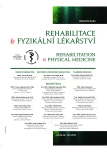The Eeffect of Perfection of Motion Paradigm on Activation of Selected Muscles in an Open and Closed Kinematic Chain
Authors:
J. Chudý 1; E. Musilová 1; M. Krčmár 2; T. Kolonyi 3; G. Buzgó 1
Authors‘ workplace:
Katedra biologických a lekárskych vied, Fakulta telesnej výchovy a športu, Univerzita Komenského v Bratislave
1; Diagnostické centrum prof. Hamara, Fakulta telesnej výchovy a športu, Univerzita Komenského v Bratislave
2; Anatomický ústav, Lekárska fakulta, Univerzita Komenského v Bratislave
3
Published in:
Rehabil. fyz. Lék., 26, 2019, No. 3, pp. 139-144.
Category:
Original Papers
Overview
Mastering correct motion paradigms, correct afferent impulses and their subsequent implementation into locomotor behavior with the possibility of usage in specific conditions of locomotion represents permanent and contemporary problems in kinesiology and sports. The selected group included 10 students of the Faculty of physical education and sports, Comenius University in Bratislava, who underwent a three-week locomotion program, when we measured changes in the isometric regiment of EMG activity of the muscles m. vastus lateralis, m. vastus medialis and m. gluteus maximus. The program of exercise of the locomotor paradigm resulted in significant changes. By comparing selected neuromuscular changes we refer to efficiency of the locomotor program in the initial phase of preparation, which is oriented to improved quality of the motion performed on the changes of muscle activation in the open (extension in the knee joint) and closed kinematic chain (the position of deep squat) which finally influence muscular activity of the whole organism.
Sources
1. AUGUSTSSON, J., THOMEE, R.:Ability of closed and open kinetic chain tests of muscular strength to assess functional performance. Scandinavian Journal of Medicine & Science in Sports, roč. 10, 2000, č. 3, s. 164-168. ISSN 0905-7188.
2. AUGUSTSSON, J. et al.: Weight training of the thigh muscles using closed versus open kinetic chain exercises: a comparison of performance enhancement. Journal of Orthopaedic & Sports Physical Therapy, roč. 27, 1998, č. 1, s. 3-8. ISSN 0190-6011.
3. CATERISANO, A. et al.: The effect of back squat depth on the EMG activity of 4 superficial hip and thigh muscles. The Journal of Strength & Conditioning Research,roč. 16, 2002, č. 3, s. 428–432. ISSN 1064-8011.
4. CONTRERAS, B.: A comparison of gluteus maximus, biceps femoris, and vastus lateralis electromyographic activity in the back squat and barbell hip thrust exercises. Journal of Applied Biomechanics, roč. 31, 2015, č. 6, s. 452-458. ISSN 1065-8483.
5. CONTRERAS, B.: A Comparison of gluteus maximus, biceps femoris, and vastus lateralis electromyography amplitude in the parallel, full , and front squat variations. Resistance-Trained Females, 2016, s. 16-22.
6. FITZGERALD, KELLEY, G.: Open versus closed kinetic chain exercise: issues in rehabilitation after anterior cruciate ligament reconstructive surgery. Physical Therapy, roč. 77, 1997, č. 12, s. 1747-1754. ISSN 0031-9023.
7. HERMENS, H. J. et al.: Development of recommendations for SEMG sensors and sensor placement procedures. Journal of Electromyography and Kinesiology, roč. 10, 2000, č. 5, s. 361-374. ISSN 1050-6411.
8. HOOPER, D. M. et al.: Open and closed kinetic chain exercises in the early period after anterior cruciate ligament reconstruction: Improvements in level walking, stair ascent, and stair descent. The American Journal of Sports Medicine, roč. 29, 2001, č. 2, s. 167-174. ISSN 0363-5465.
9. KAMPMILLER, T., VANDERKA, M.: Teoretické východiská štruktúry a rozvoja silových schopností. In MORAVEC, R. et al. Teória a didaktika výkonnostného a vrcholového športu. Bratislava, FTVŠ UK a SVS pre TVaŠ, 2007, s. 89-107. ISBN 978-80-89075-31-7.
10. KVIST, J., GILLQUIST, J.: Sagittal plane knee translation and electromyographic activity during closed and open kinetic chain exercises in anterior cruciate ligament-deficient patients and control subjects. The American Journal of Sports Medicine, roč. 29, 2001, č. 1, s. 72-82. ISSN 0363-5465.
11. LUTZ, G. E. et al.: Comparison of tibiofemoral joint forces during open-kinetic-chain and closed-kinetic-chain exercises. JBJS, roč. 75, 1993, č. 5, s. 732-739. ISSN 0021-9355.
12. MARCHETTI, P. H. et al.: Muscle activation differs between three different knee joint-angle positions during a maximal isometric back. Squat Exercise, roč. 2016.
13. PALMITIER, R. A. et al.: Kinetic chain exercise in knee rehabilitation. Sports Medicine, roč. 11, 1991, č. 6, s. 402-413. ISSN 0112-1642.
14. ROBERTSON, D. G. E. et al.: Lower extremity muscle functions during full. Squats, 2008, s. 333-339.
15 - STENSDOTTER, A. K. et al.: Quadriceps activation in closed and in open kinetic chain exercise. Medicine & Science in Sports & Exercise, roč. 35, 2003, č. 12, s. 2043-2047.
16. VAN DEN TILLAAR, R. et al.: Comparison of muscle activation and kinematics during free-weight back squats with different loads. PloS one, roč. 14, 2019, č. 5, s. e0217044. ISSN 1932-6203.
17. WITVROUW, E. et al.: Open versus closed kinetic chain exercises in patellofemoral pain: a 5-year prospective randomized study. The American Journal of Sports Medicin, roč. 32, 2004, č. 5, s. 1122-1130. ISSN 0363-5465.
18. YESSIS, M.: Zásobník cviků – kineziologie (zvláštní vydání Muscle&Fitness), Brno: Fitplus International Publishing, 2005
Labels
Physiotherapist, university degree Rehabilitation Sports medicineArticle was published in
Rehabilitation & Physical Medicine

2019 Issue 3
Most read in this issue
- Interconnection of Physiotherapy and Psychology in Sport
- The Effect of Tibial Osteotomy on the Gait Kinematics in Patients with Knee Arthritis - Pilot Study
- Comparison of Time Requirements, Financial Accessibility and Reliability of Tests of Fine Motoric for Patients after Vascular Cerebral Stroke from the Ergotherapy Standpoint
- The Eeffect of Perfection of Motion Paradigm on Activation of Selected Muscles in an Open and Closed Kinematic Chain
